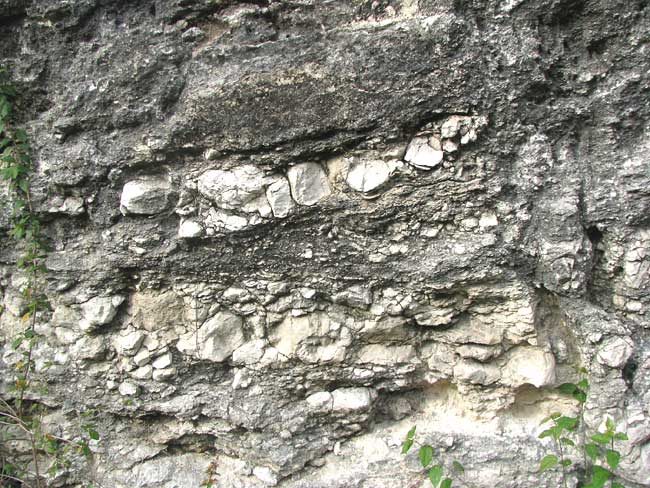Excerpts from Jim Conrad's
Naturalist Newsletter

from the January 24, 2010 Newsletter issued from Hacienda Chichen Resort beside Chichén Itzá Ruins, central Yucatán, MÉXICO
MYSTERIOUS ROADCUT
Each week when I hike to Pisté to buy fruit, on Hwy 180 between Mérida and Cancún and about half a mile from the center of the ruins of Chichén Itzá, I pass within ten feet of the roadcut through limestone shown above. That's a vertical section of the roadcut about six feet high. Note the weeds at the lower right for scale.
About 65 millions years ago the entire Yucatan Peninsula was covered by sea, as was much of the US Southeastern Coastal Plain. At that time, at the end of the Cretaceous Period, an object from space at least six-miles wide (10 km) crashed into the sea at a spot now located -- after the Yucatan Peninsula has risen above sea level -- a few miles off the Yucatan's northwestern coast. The crater caused by that impact, today known as the Chicxulub Crater, was about 112 miles in diameter (180 kms). The Wikipedia page describing the Chicxulub Crater is at https://en.wikipedia.org/wiki/Chicxulub_crater.
Long after the crater was formed, during the Oligocene about 25 million years ago, this part of the Yucatan Peninsula began rising, pushed upwards by forces from within the Earth. What earlier had been the carbonate- rich mud of the ocean floor, and limestone rock below it lithified from that mud, gradually rose and kept rising until today it stands above sea level, but not by much. During those millions of years ocean currents gradually buried the Chicxulub Crater beneath mud that eventually hardened into limestone rock. Today if you stand where earlier the crater was formed, you'll see no signs of a crater at all. It's all buried beneath limestone deposited since the impact 65 million years ago. At Chichén Itzá we're well outside the crater's former location, but close enough for the ocean floor here to have been very disrupted.
The mysterious thing about the roadcut is that what you see there suggests a great deal of turmoil. Sediment deposited in calm, seabed conditions is finely grained and the layering is even. The picture shows very uneven layering, some layers tilted and others not, and fragments of fractured rock appear to be embedded in what once was flowing mud. Maybe there's even a near-vertical fault cutting across the layers at the picture's right. I've seen layering like this in ancient mudflows beside volcanoes, but never in limestone areas that have been as geologically quiet as this one -- quiet since the Chicxulub Crater was formed. In fact, I can't think of anything in the Yucatan Peninsula's geological history that could have created such a story of geological turmoil as this picture suggests, except the Chicxulub Impact.
It seems that if such a wonderful exhibition of the effects of the Chicxulub Impact were known, it'd appear at websites dealing with the event -- would even be an important tourist attraction. The Chicxulub Impact, after all, is often regarded as having killed off the dinosaurs worldwide, thus enabling mammals to begin their evolutionary ascendancy, eventually making possible humanity.
Is there anyone out there who can confirm that what's in the picture is or is not evidence of the Chicxulub Impact?
from the December 13, 2015 Newsletter issued from Hacienda Chichen Resort beside Chichén Itzá Ruins, central Yucatán, MÉXICO
OUR HOLEY LIMESTONE
During the last month the exposure shown in the above section has been obliterated as they widened the road. However, new roadcuts have been exposed, and as rain washes them clean they show ever more interesting details. Below, you can see some at a new cut:.

The Yucatan Peninsula is a big slab of limestone, and limestone is famous for its caves and underground rivers. The above picture shows two openings to subterranean chambers, the one on the left mostly blocked by boulders dumped there by the road crew, apparently in a half-hearted attempt to seal it, and the one on the right also is mostly blocked, but not so completely. These give an idea of how common such "solution features" are in this area's limestone.
The picture was taken quite close to Chichén Itzá ruins. Recently I heard through the Maya-laborer grapevine that some local laborers were part of a team that discovered that the big pyramid at Chichén Itzá sits atop a cave, which may have played part in the ancient Maya priest's job of communicating with spirits of the underworld. And one can imagine the effect of a priest emerging from atop the pyramid when the whole community is sure that no one has climbed those sacred steps for a long time.
I've not heard of such a discovery being formally announced, so it may be only a rumor. However, it's fun to think about when I bike past these openings on my way to Pisté to buy bananas.